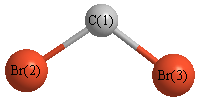Jump to
S2C1
Energy calculated at B2PLYP=FULLultrafine/STO-3G
| | hartrees |
|---|
| Energy at 0K | -5128.821083 |
| Energy at 298.15K | |
| HF Energy | -5128.789043 |
| Nuclear repulsion energy | 318.864536 |
The energy at 298.15K was derived from the energy at 0K
and an integrated heat capacity that used the calculated vibrational frequencies.
Geometric Data calculated at B2PLYP=FULLultrafine/STO-3G
Point Group is C2v
Cartesians (Å)
| Atom |
x (Å) |
y (Å) |
z (Å) |
|---|
| C1 |
0.000 |
0.000 |
1.047 |
| Br2 |
0.000 |
1.583 |
-0.090 |
| Br3 |
0.000 |
-1.583 |
-0.090 |
Atom - Atom Distances (Å)
| |
C1 |
Br2 |
Br3 |
| C1 | | 1.9487 | 1.9487 |
Br2 | 1.9487 | | 3.1651 | Br3 | 1.9487 | 3.1651 | |
 More geometry information
More geometry information
Calculated Bond Angles
| atom1 |
atom2 |
atom3 |
angle |
|
atom1 |
atom2 |
atom3 |
angle |
| Br2 |
C1 |
Br3 |
108.601 |
|
Electronic energy levels
Charges, Dipole, Quadrupole and Polarizability
Jump to
S1C1
Energy calculated at B2PLYP=FULLultrafine/STO-3G
| | hartrees |
|---|
| Energy at 0K | -5128.792077 |
| Energy at 298.15K | -5128.797092 |
| HF Energy | -5128.792077 |
| Nuclear repulsion energy | 311.039813 |
The energy at 298.15K was derived from the energy at 0K
and an integrated heat capacity that used the calculated vibrational frequencies.
Geometric Data calculated at B2PLYP=FULLultrafine/STO-3G
Point Group is C2v
Cartesians (Å)
| Atom |
x (Å) |
y (Å) |
z (Å) |
|---|
| C1 |
0.000 |
0.000 |
0.754 |
| Br2 |
0.000 |
1.685 |
-0.065 |
| Br3 |
0.000 |
-1.685 |
-0.065 |
Atom - Atom Distances (Å)
| |
C1 |
Br2 |
Br3 |
| C1 | | 1.8731 | 1.8731 |
Br2 | 1.8731 | | 3.3695 | Br3 | 1.8731 | 3.3695 | |
 More geometry information
More geometry information
Electronic energy levels
Charges, Dipole, Quadrupole and Polarizability
